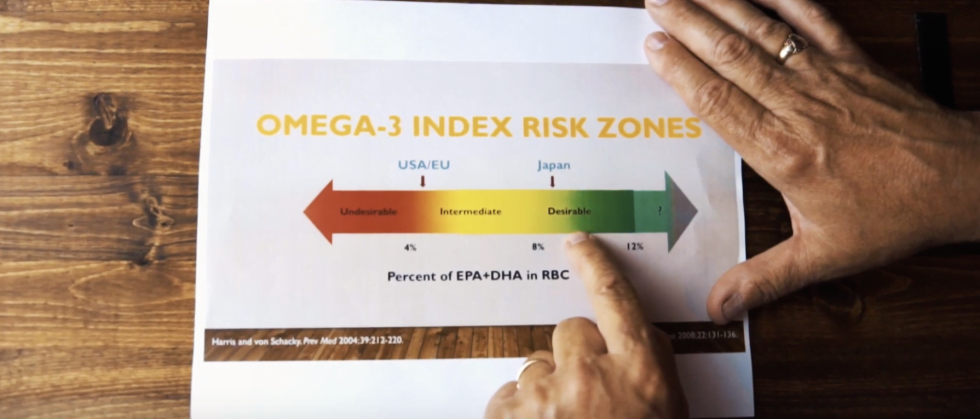What your result actually measures
Your Omega-3 Index is the percentage of EPA and DHA embedded in your red blood cell membranes. We total all fatty acids in those membranes and express EPA+DHA as a fraction of that whole—so a 6% result means 6% of your RBC fatty acids are EPA and DHA. Across many studies, an index in the 8–12% range is linked with better heart, brain, eye, and joint outcomes. Most people eating a typical Western diet land closer to ~5%. That doesn’t mean you’re “unhealthy,” but, as with blood pressure or A1c, higher within the validated range is generally better.
Why so many people score below 8%
Diet patterns drive the number. Those who rarely eat oily fish and don’t supplement commonly sit at 4–6%. Age and sex play a role (younger adults and men trend lower), but intake is the dominant lever. In a large free-living cohort, participants who ate three non-fried fish meals weekly and used an EPA/DHA supplement were the most likely to reach or exceed 8%, while non-fish eaters who skipped supplements averaged ~4.1%.
Using food to move the needle
If you prefer plate over pill, choose species naturally rich in EPA and DHA and rotate them regularly. Two people can both “eat fish often,” yet only the one choosing high-EPA/DHA species will see their Index climb. Even within a species (e.g., farmed salmon), omega-3 content varies with feed. The only way to confirm your menu is working is to re-test after several months.
When supplements make sense—and how to read the label
Dose is king. To lift an Index sitting around 5–6% into the green zone, most people need roughly 1,000 mg of combined EPA+DHA daily, taken with a meal that contains fat to aid absorption. Check the Supplement Facts panel for the actual milligrams of EPA and DHA per serving (not just “fish oil” grams). Triglyceride and phospholipid forms are generally absorbed better than ethyl esters, and emulsified or liposomal formats can help, but these formulation nuances matter less than consistently reaching an effective EPA+DHA dose you can afford and tolerate.
How much do you personally need?
Population guidance is a starting point; your baseline, metabolism, and product type matter. Modeling research suggests that, over ~13 weeks, someone starting near 4–5% taking ~840 mg/day of EPA+DHA (as ethyl esters) might reach ~6.5%. To target ~8%, estimated daily needs often rise to 1,500–2,200 mg for lower baselines, with smaller doses (~750 mg) sufficing when you’re already near 6%. Think in weekly totals if that’s easier—your RBCs reflect months of intake, not yesterday’s capsule.
“Can I overshoot?” and other safety notes
As with any nutrient, “too much” exists in theory, but levels seen in high-fish cultures (average Index ~9%) track with longevity and lower cardiac risk. OmegaQuant recommends 8–12% because that’s where outcome data are strongest; there isn’t evidence that values modestly above this band are harmful. In the U.S., intakes up to 3,000 mg/day of EPA+DHA are generally recognized as safe for adults (5,000 mg/day in the EU). If you’re on anticoagulants or have a bleeding disorder, loop in your clinician before making big changes.
What about plant-based omega-3s?
Walnuts, chia, flax, and similar foods provide ALA, which the body converts only sparingly to EPA and minimally to DHA. ALA is healthful, but it rarely lifts the Omega-3 Index on its own. If you avoid fish, algal-derived DHA (often with some EPA) is a vegan, effective way to raise your number.
How to test and re-test with purpose
Treat your first result as your baseline. Adjust your intake—via food, supplements, or both—then re-check in 3–4 months to see how your red blood cells responded. Once you’re stable in the 8–12% range and your routine is steady, annual or semi-annual testing keeps you on track. Pay attention to how you feel along the way; many people notice parallel improvements in dry eye comfort, joint niggles, or exercise recovery as their Index climbs.
A quick word on product quality and timing
Take your omega-3 with a main meal for better uptake, store oils away from heat and light, and choose brands that disclose EPA and DHA amounts clearly and test for purity. Remember that you can’t “cram” the night before a test—RBC levels reflect the prior 3–4 months, not yesterday’s dose.
Why this metric is trusted
The Omega-3 Index has been used in 200+ peer-reviewed studies and across collaborations with more than 100 research institutions. It’s a tissue-reflective, stable biomarker with clear, actionable targets—one number that turns everyday choices about fish and supplements into measurable progress for long-term health.




